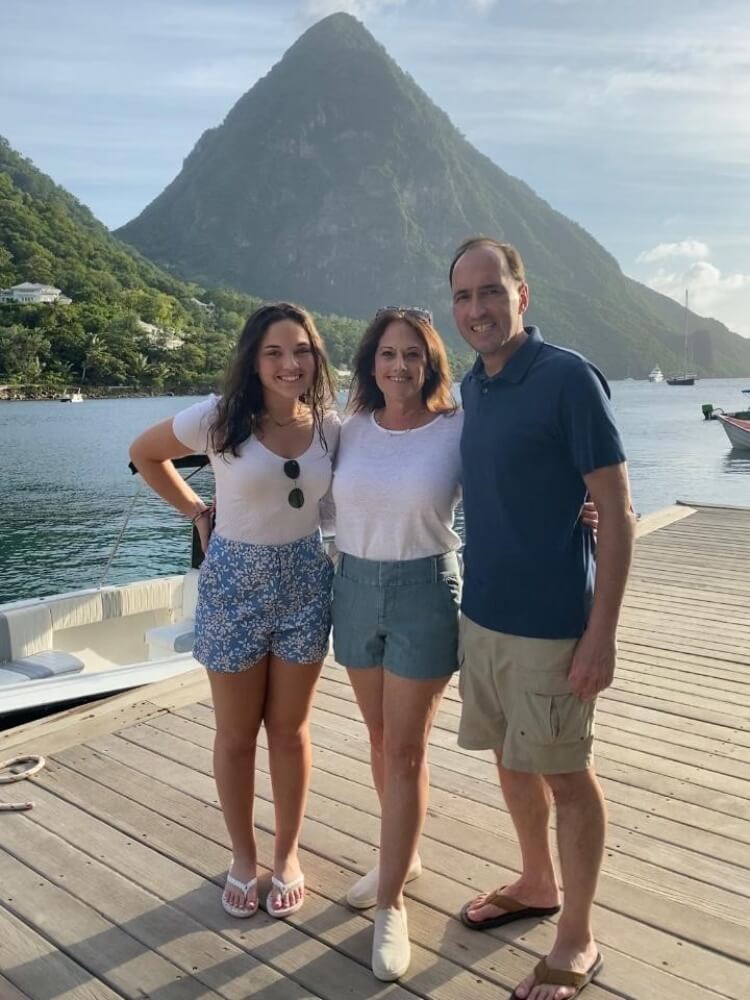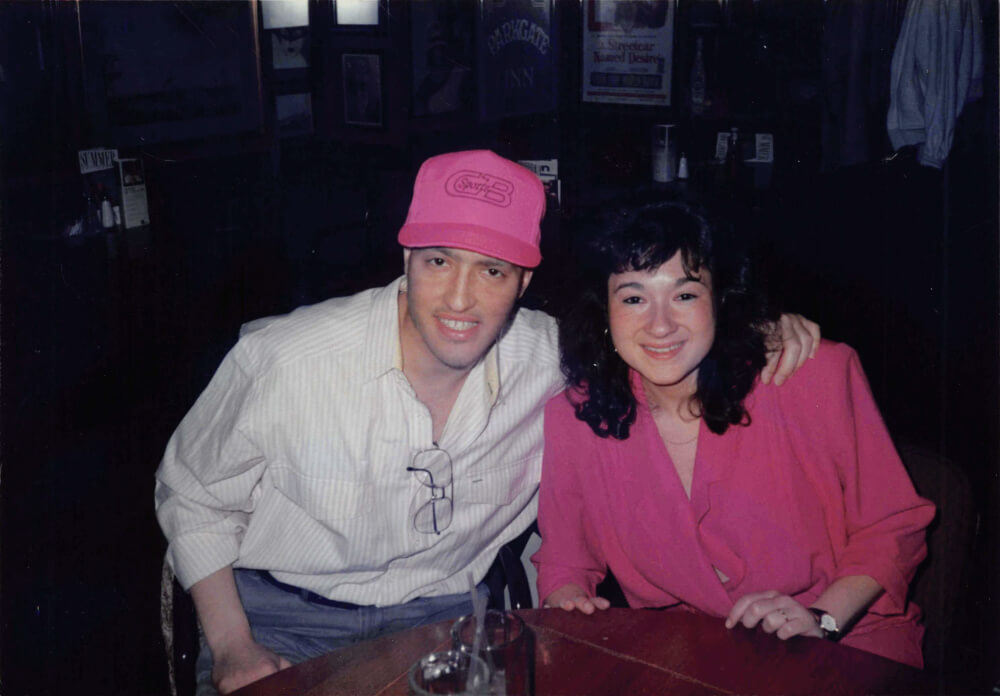By Howard Brown
As the Adult Stem Cell Transplant Program at Dana-Farber celebrates its 50th anniversary, one cancer survivor whose 1990 transplant came when the procedure was far more arduous — and far less successful — reflects on his experience.
I have a four-by-three-inch plastic bag that I’ve saved for more than 32 years. It’s smaller than a bag of frozen peas, and yellowing with age, but I’ll never get rid of it.
That bag saved my life.
The story starts in 1989. I was 23 years old, recently graduated from Babson College, and had moved from Boston to Dayton, Ohio for a great new job. A red bump appeared on my cheek; I didn’t think anything of it. But it kept getting bigger, from small marble to big marble to golf ball-sized. My parents made me go to the doctor when I came home for a visit, and a biopsy was done on it. Four or five weeks later, the doctors called me in and said, “You have an appointment at Dana-Farber.”
That’s where I learned my diagnosis on October 7, 1989: stage IV T-cell lymphoma, a rare type of non-Hodgkin lymphoma.
I remember looking up at Eric Rubin, one of the doctors in the room, and asking what they were talking about. I was young, in great shape — playing basketball all the time, traveling around the country for work — and now I needed to start chemotherapy immediately? It was surreal.

Wonder twin match
When I showed up at Dana-Farber for my first chemotherapy infusion, Dr. Rubin came to see me after my blood draws. He told me, “We’re not ready to start yet because your liver function tests are too high today. We need to send you on a field trip first.” I asked, “What do you mean? This cancer is aggressive — we need to act right away.” But he insisted, and the trip turned out to be to Newton-Wellesley Hospital so I could provide a sperm sample to be frozen in case I needed it later. Future kids were not on my 23-year-old mind, so I’m glad Dr. Rubin had the vision and wherewithal to make sure I did fertility preservation.
Chemotherapy started the next day. I did one protocol, relapsed, and then started another — and another. It seemed like I was getting blood and platelet transfusions all the time, but it turned out I needed a stem cell transplant to survive. My twin sister Cheryl — we call each other the “Wonder Twins” after the old cartoon superheroes — was tested, and turned out to be a perfect match as my donor. One of my other doctors, Robert Soiffer, MD, said the chances were about 1 in 4 to find a perfect match in a sibling, even a twin.
I met my transplant team and they set the procedure for May 24, 1990. They explained that my body might reject the transplant immediately, or over time, or in the best case that Cheryl’s immune system would take over and kill the malignancies. First they had to wipe out my immune system, which meant heavy-duty chemotherapy and then full-body radiation twice daily for five days leading up to the transplant. I knew there were risks. Some other people we met who had transplants immediately rejected the donor stem cells, but I put my faith in George Canellos, MD, Dr. Rubin, Dr. Soiffer, and my entire transplant team.
While I waited in a sterile and isolated room with my father, Marshall, on May 24, Cheryl was next door with our mother, Nancy, at Brigham and Women’s Hospital — watching her magenta-colored stem cells pass from her body into a small bag. Then the bag was whisked over to Dana-Farber for processing and delivered into my room, where Cheryl’s cells passed into me intravenously. Now we truly were wonder twins.
Once the process was done, the empty bag was just sitting there. I don’t know why I did this, but I picked it up and said, “Mom, put this in your purse.” Who does that? We still didn’t even know if the transplant was going to work, but for some reason I wanted that bag. She said OK.

Advocate and author
A lot has happened since. The transplant worked. I spent more than a month in isolation at Dana-Farber after the procedure, and then more recovery at home with my parents outside Boston. Realizing I needed a fresh start, I moved first to Los Angeles — where I met my wife, Lisa Naftaly. We got married in the summer of 1994, and it turns out I did need the sperm that Dr. Rubin had insisted I freeze back in 1989. Our daughter, Emily, was born in August of 2001, and is now a senior in college. We all live in Michigan, just a short distance from Cheryl, her husband, and their kids. Both our families relocated so our children and families could grow up together.
Unfortunately, cancer was not through with me. In June 2016, twenty-six years after my first diagnosis, I went in for my age 50 colonoscopy. I woke up with Lisa holding my hand, and my gastroenterologist at our bedside. He told us that he had found a tumor in my cecum that turned out to be stage III colon cancer. I had 13 ½ inches of my colon removed, followed by months of intense chemotherapy. Despite this treatment, another stage III tumor grew, resulting in 10 ½ inches more of my colon being removed. Within a few months, the cancer spread to my liver, peritoneum, omentum, and small bowel. I now had stage IV metastatic colon cancer, and was told I had three to six months to live if they could not find an effective treatment.
I started a new chemo cocktail for the rest of 2017, but still, it was only a matter of time before the cancer found its way around these meds. In March of 2018 I underwent a massive 13-hour surgery called Cytoreductive (CRS) hyperthermic intraperitoneal chemotherapy (HIPEC) — in which all visible signs of cancer were excised, and then heated chemotherapy drugs were poured directly into my abdomen to eliminate any remaining cancerous cells.
Currently I have no evidence of disease (NED) and am a national colorectal cancer advocate who speaks across the country about the importance of regular screenings and colonoscopies for everybody starting at age 45. If I had one earlier, instead of at 50, there is a good chance my tumors would have been a stage I polyp they could have snipped out. I’ve also written a book, Shining Brightly, that tells my story — but is not a cancer story. It’s about how no matter what challenges we face in life, we can all be resilient. We can all shine our light to make our own lives and the lives of others better.
And that’s why I keep that plastic bag in a sealed envelope, right alongside other special mementos from my life. Without that bag, without Cheryl my wonder twin, and without Dana-Farber, I would not be able to shine brightly today. For that I am immensely grateful.

What a wondrous story and strange journey my dear brother Howard. It is so sad because of the long journey of pain. But what a hero you are, and determination to defeat the disease.
I wish you all the best.
I was asked about stem cell and marrow registries. http://www.bethematch.com and http://www.giftoflife.com – consider a cheek swab kit and register
Thank you for sharing your inspiring story.
Howard, your positive, loving and determined spirt has inspired me since I met you 10 years ago. Here’s to another 50 productive, healthy years. Sharon
Thank your for sharing your amazing story of your inspirational journey. Resilience, a positive attitude, and excellent health. I loved that the doctor had you freeze your sperm to enable you to father children. I am 2 years and 6 months from my stem cell transplant. I survived and am so grateful to my team at Dana Farber especially Dr. Rizwan Romee. It does take a village. Bless you.
Dear Howard,
Your story is very moving. thank you for sharing it. Kathy
You have been a warrior on fighting for your survival. DFCI and BWH offer the best care. Blessing to you in your fight. I am now a 10 year survivor of cancer twice including a stem cell transplant with my own cells. Stay strong❤️🙏🏻
As a 2-time NHL cancer survivor, I’m so glad I clicked on your story in the DFCI newsletter email. If my cancer ever returns or if I get another one, I will turn to your story for inspiration and hope.